- Markets, finance and governance
- Financing (taxes, tariffs, transfers) and cost estimates
- World Bank: choose the best sanitation system like shopping in a supermarket
World Bank: choose the best sanitation system like shopping in a supermarket
8912 views
- joeturner
-
 Topic AuthorLess
Topic AuthorLess- Posts: 717
- Karma: 23
- Likes received: 185
Re: World Bank: choose the best sanitation system like shopping in a supermarket
I recently spoke to an official from the Water Regulator in an EU country. He said that where water and sanitation services were provided in an affordable, safe way to people, they should be forced (by law) to use it.
At the same meeting, I spoke to another official from a different EU country who was talking about the value of dispersed self-managed sanitation systems.
They were both talking about risk, the first saying that there was a risk in people digging their own boreholes and having their own latrines in that they might impact on everyone else and the municipal system in urban areas. The other was saying that the population was very dispersed and (I think) largely living on rock, so the difficulties of building sewers etc are much higher and risks of operating your own system is much lower.
I have had this debate elsewhere and there seem to be a fairly large number of people who think they have a 'human right' to manage their own sanitation system, and that in fact the state is somehow impacting on their human rights by requiring the use of provided sanitation systems.
Please Log in to join the conversation.
You need to login to replyRe: World Bank: choose the best sanitation system like shopping in a supermarket
forum.susana.org/forum/categories/5-clts...it=12&start=36#10479
The focus was CLTS but in special the point that people should decide their sanitation solution with out advise.
I can´t find the other entries so I will point it out again.
Ben wrote yesterday also
I don´t agree with this statement.I feel you gave up on the belief that people, even the poorest uneducated ones, can and have the right to vote / decide / organise themselves in a democratic / cooperative way to choose their best water and sanitation management system.
Lets talk here only about onsite systems. I think the sanitation decision even at household level is not a personal right in populated areas (lets leave out the houses out in the middle of nowhere). For me santiation is a necessary organization of waste management you have to have in a society, when the density of the houses becomes so high, that your behavior is influencing the life of others. Therefore most countries have laws which force you to connect AND USE a sewer when it is available. In Germany there are some people fighting hard not to have that obligation but only in some rare cases it is allowed. Why? Because health is a public issue. Looking at this I do not understand why in a poor settlement the people should be allowed to choose their sanitation system. Very often the discussion mixes up the right to have your bathroom as you want to have it with the right to choose the sanitation system.
Some examples:
- High water table and flooding sometimes. You can not be allowed to build an unlined pit latrine because it is cheaper , the only solution are lined systems with organized recollection. But if you have to organize a recollection, in order to be economic you have to have a standard – for instance as they did in the project in Uganda, with a standardized snorkel where you can suck the fecal sludge. When every body builds as he/she wants, organized sanitation solutions are not possible.
- The same would be if you have mixed up UDDT with septic tanks. The final treatment is different so you would have to construct two treatments (I am looking on the large picture not the current situation where for both is no solution present). So you would have to pass with two different trucks (one for dry material the other a honeysucker).
- Even at a less elaborated level. Imagine you are implanting a sanitation solution – you have a fixed subsidy for each house. Some say they wish a pit latrine (as it is cheaper) some a UDDT and some pour flush. But YOU know about the return of each system and are convinced one solution is the best for this case.
In my opinion it is your obligation as the expert to make the decision and offer the solution you are convinced – you should discuss it with the utility (if existent) and the society, but not with each user. It is your responsibility. As it is mine as an engineer to choose the right treatment plant for a city – I will not discuss that treatment with each house – I will do a presentation to lay out the reasons and the chosen treatment to the society as a whole.
Ui ui a lot of rambling but this point really is a point I don´t understand why so many people think it should be a decision of the people. Did you understand my point? I would be interested in hearing your opinion.
Christoph
Please Log in to join the conversation.
You need to login to replyRe: World Bank: choose the best sanitation system like shopping in a supermarket
I am curious about the your statement:
I think it is more or less the same aspect we discussed several times before - demand driven is dangerous without a full understanding of consequences – what do you understand be demand driven varies widely. I think that aspect has to be treated VERY carefully.
I am sure you have a sound reasoning, could you explain a little more, or point me to the relevant discussion.
Regards
Marijn
E: This email address is being protected from spambots. You need JavaScript enabled to view it.
Please Log in to join the conversation.
You need to login to reply- isis
-
Less
- Posts: 17
- Likes received: 3
Re: World Bank: choose the best sanitation system like shopping in a supermarket
I have not read the report, just this discussion thread. Thus, I do not know about how the information was collected and what specific questions were asked to the surveyed population.
Anyhow, in rural areas, the stats relating to OD preference, may not be that shocking. That is, yes people may have a latrine at home, but they still may prefer to use the outdoors when nature calls. This is plausible, if you consider that someone tending his/her fields may not have a latrine near by when nature calls. In rural areas, such practices have a much lower sanitary risk than in urban and peri-urban contexts.
I have no experience in farms in developed countries, but I wonder what their defecation practices are when at work. Do farmers just hold it in until what ever they are doing is over? Do they proceed immediately to their house to use the facilities? Or do they "sneak one in" (i.e. open defecation) somewhere with a bit of privacy? The latter seems to be what I have witnessed in developing countries. If you consider that a lot of farming labour is done by migrant workers (in many European and N. American countries) that are many times "exploited" by the hour, I highly doubt that a trip back to where ever the facilities are is an option.
Isis
WASH junkie
Please Log in to join the conversation.
You need to login to reply- Hutton
-
Less
- Posts: 8
- Karma: 2
- Likes received: 2
Re: World Bank: choose the best sanitation system like shopping in a supermarket
The rate of latrine use/non-use is from a survey we conducted in each of the 47 selected field locations of the study across 6 countries, and so relied on households self-reporting of practices. As these are very context-specific, the estimates may differ from other people's experiences and data in the same countries.
Agreed that there are many types of latrine/toilet so we had to choose major categories for comparison, and take the average costs for those observed in the surveyed households. So a wet pit in rural may vary from urban, as well as variation between countries.
There are some hard-to-explain differences in benefit proportions between countries. A standardised methodology (same spreadsheets) was applied and there was continual follow-up and correction in the 6 countries to ensure consistency in assumptions, but at the end there were still some variations in input data which led to these differences.
Anyway, I am glad that this paper has led to some much needed discussion around the economics of sanitation. In the near future, WSP will be releasing the Economics of Sanitation Initiative online Toolkit, which will enable users to conduct their own analyses and explore the impact of change in assumptions on the results.
Please Log in to join the conversation.
You need to login to replyRe: World Bank: choose the best sanitation system like shopping in a supermarket
Very interesting stuff.
The table below is shocking for some countries. Even though people have a toilet, 44% in Cambodia in the rural areas prefer to continue with OD. Black as you are working there do you have an explanation? Almost evenly surprising to me is the aspect that in Vietnam 25% of users who have access to a toilet prefer continuing OD (16% urban in the Philippines). Those working there (Frank, Robert) could you give a guess?
For me also not understandable, why do people go a way out to deposit stool of their children when they have a toilet – and as in Yunan they use it frequently.
Although I find the study interesting, I am missing methodology explanation in this study (it is partly in the annex). There is not much information about the total numbers of samples, why E. coli is used when normally we use fecal coliforms (E. coli is very limited)
There is a conclusion in page 39 I don´t think it is correct.
I think it is the other way round – if you have a higher income level you have a toilet, but I doubt, that the toilet will raise your income level (significantly).Public sanitation programs targeting households without access to a basic level of household sanitation are likely to have a positive redistributive effect in society, because of the strong correlation between income level and sanitation coverage.
There is conclusion I do agree with in general but not with the underlying conclusion:
So far so good. But following they writeTherefore, the fifth recommendation is that considerable further attention is given to improving program design and implementation, in order to capture the full benefits of sanitation programs.
I think it is more or less the same aspect we discussed several times before - demand driven is dangerous without a full understanding of consequences – what do you understand be demand driven varies widely. I think that aspect has to be treated VERY carefully.Sanitation programs need to be more people-centered: they need to be demand-driven.
Finally coming to the Annex I found some explanations about how they did came to the numbers.
See this table.
But this does not explain to me why the access time for a wet toilet is so much more valuable than for a dry pit in some cases (Cambodia and Philippines). In my understanding it should be the same. In the case of the Philipppines it reverses the finding of the study.
And in general I do have my problems with the working time consideration in order to explain the benefit. It would be interesting to know how much local (country) decision makers really consider the wasted working time of a person due to health or access timeloss.
Christoph
Attachments:
-
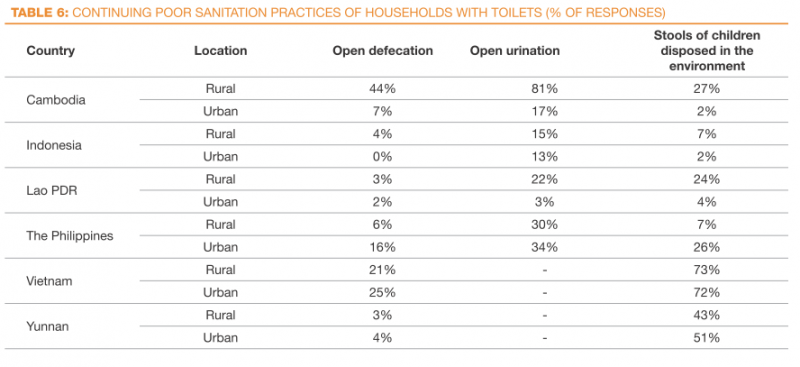 odIMG_2901...1716.png
(Filesize: 148KB)
odIMG_2901...1716.png
(Filesize: 148KB)
-
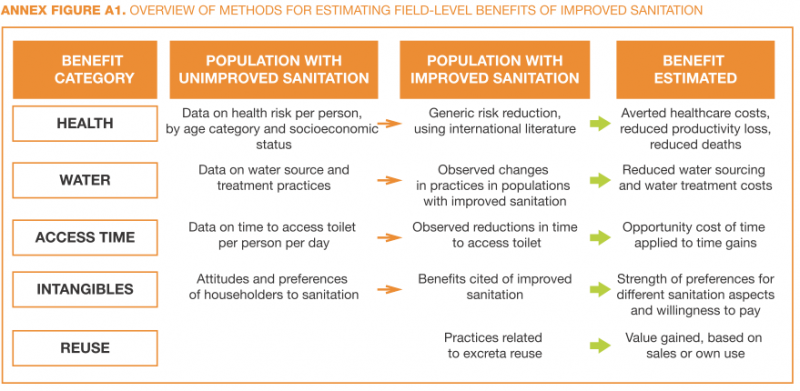 methIMG_29...5738.png
(Filesize: 272KB)
methIMG_29...5738.png
(Filesize: 272KB)
Please Log in to join the conversation.
You need to login to replyRe: World Bank: choose the best sanitation system like shopping in a supermarket
Please Log in to join the conversation.
You need to login to replyRe: World Bank: choose the best sanitation system like shopping in a supermarket
Some first quick obersvations.
a) dry pit and UDDT are clearly two different aspects (answering my questio nfrom below)
b) there is a very intresting explanation for the UDDT outcome of the graph you posted or of this one
The explanation is given on page 12
In Yunnan the UDDT option has a higher ratio than that for a pit latrine. This was ac-
complished through a large-scale government program that made the unit cost of UDDT facilities similar to that of ordinary pit latrines. In the Philippines, returns for UDDT
were significantly lower than those from pit latrines, due to the high hardware and software unit costs of delivering
UDDT to populations.
I keep reading
Christoph
Attachments:
-
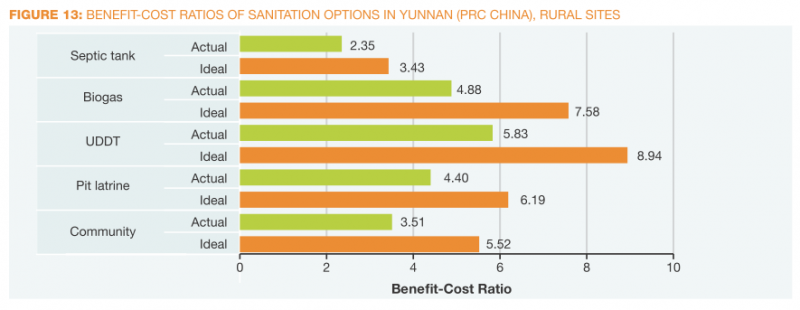 uddtIMG_29...4815.png
(Filesize: 186KB)
uddtIMG_29...4815.png
(Filesize: 186KB)
Please Log in to join the conversation.
You need to login to reply- joeturner
-
 Topic AuthorLess
Topic AuthorLess- Posts: 717
- Karma: 23
- Likes received: 185
Re: World Bank: choose the best sanitation system like shopping in a supermarket
I'm a bit skeptical about this graph, especially that the composting toilets have come out so far ahead.
Attachments:
-
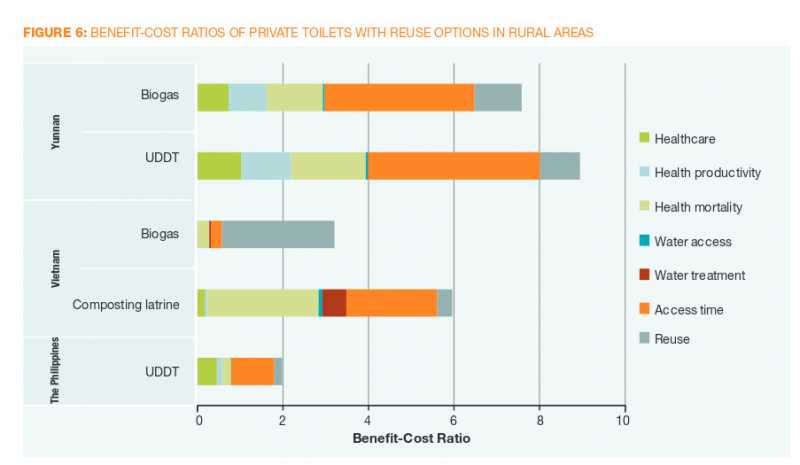 latrine.jpg
(Filesize: 20KB)
latrine.jpg
(Filesize: 20KB)
Please Log in to join the conversation.
You need to login to reply- joeturner
-
 Topic AuthorLess
Topic AuthorLess- Posts: 717
- Karma: 23
- Likes received: 185
Re: World Bank: choose the best sanitation system like shopping in a supermarket
www.wsp.org/sites/wsp.org/files/publicat...Synthesis-Report.pdf
I am not an Economist - so I might be missing something important - but it is interesting that they have used DALYs (disability adjusted life years) to assess the value of the different sanitation systems. So it looks like they're looking at the cost-benefits in terms of DALYs saved.
Which maybe doesn't work very well - one might postulate a wide increase in community DALYs which actually doesn't represent much of an improvement in individuals. Or maybe it says that it is fairly cheap to show an improvement from OD to anything else - but much more difficult/expensive to get a further health/fatality improvement.
It also doesn't look like they have included the potential wider (say health, environmental) costs of the technology nor the risks of catastrophic failure.
Page 35 gives details of the interventions considered, it doesn't look like they are any more specific than wet/dry latrines.
Please Log in to join the conversation.
You need to login to replyRe: World Bank: choose the best sanitation system like shopping in a supermarket
what is dry pit? just a regular pit latrine without pour flush or UDDT? I guess the first.^
I do not understand why the access has such a strong influence. And why the healthcare value differs so much from country to country.
Maybe Guy could help us out?
Regards
Christoph
Attachments:
-
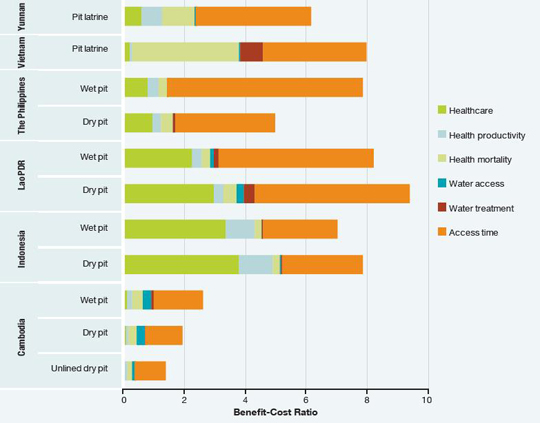 figure-sho...-540.jpg
(Filesize: 117KB)
figure-sho...-540.jpg
(Filesize: 117KB)
Please Log in to join the conversation.
You need to login to reply- joeturner
-
 Topic AuthorLess
Topic AuthorLess- Posts: 717
- Karma: 23
- Likes received: 185
World Bank: choose the best sanitation system like shopping in a supermarket
blogs.worldbank.org/water/why-choosing-p...logSocialShare_D_EXT
The final graph showing cost-benefits in Indonesia suggests (perhaps only for that one place and time) that wet pit latrines are most cost effective. I wonder what they've included in the calculation.
And anyway, surely this should be a risk based process rather than just a cost-benefit?
Thanks to Cor Dietvorst for the link.
Please Log in to join the conversation.
You need to login to reply- Markets, finance and governance
- Financing (taxes, tariffs, transfers) and cost estimates
- World Bank: choose the best sanitation system like shopping in a supermarket








